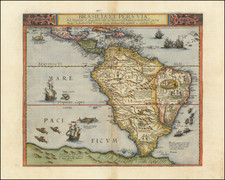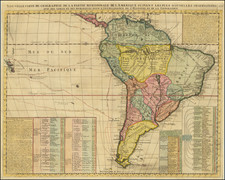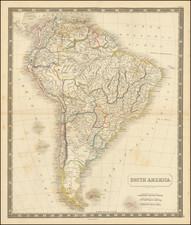Spectacular large format map of Venezuela, credited to Felipe Bauza y Canas, most likely the son of the Felipe Bauza who served as the Hydrographer on Alessandro Malaspina's expedition to the Pacific (1788-1794), who would go on to become the head of the Spanish Hydrographical Office (1815-1823) and one of the most respected mapmakers of his generation.
As noted in the official report of the Venezuela-British Guiana boundary arbitration
The . . .map . . . of 1841 (is) by the Spanish engineer, Dem Felipe Bauza, comprising various provinces and parts of others, among these Guiana. It is founded upon the work of Churucca, and Fidalgo, as well as that Ferrer, and very particularly upon that of Baron de Humboldt, and on the unpublished charts and private plans of Solano, and on those of the campaign of General Murillo, and many documents of the officers of the Royal Armarda, Doz and Guerrero, and of the engineers Cramer and Primo de Rivera, of Don Jose de Inciarte and of the pilot of the Spanish trade to the Indies, Don Joaquin Morreno. It is duly certified in Madrid on May 4, 1898, by the archivist of the Archives of the Hydrographic Office, Senor Joaquin de Ariza, for James H. Reddan, Commissioner of the Government of Her Britannic Majesty. It shows all of the towns, villages, places, existing and ruined, missions, ranches, farms, sugar mills, cattle farms, castles, towers, Indian villages, silver mines, trails, roads and royal highways.
It gives as the boundaries of British Guiana a line which starts from a point on Moruka Creek and runs in a southwesterly direction to the Rinocote Mountains, and from thence runs to the southeast and terminates at the source of the Pomeroon River, apparently in conformity with that of Humboldt, which is elsewhere analyzed.
Felipe Bauza (1764-1834) was a Spanish naval hydrographer who served in important roles on the Malaspina expedition and in the Spanish hydrographic administration. Born in Palma, Majorca, Bauza joined the Spanish navy at fifteen. A promising young officer, Tofiño y Varela employed him on surveying for the maritime atlas of Spain.
This work got him appointed as a hydrographer on the Malaspina expedition, Spain’s answer to the voyages of James Cook and La Perouse. Bauza was in charge of charting on the expedition. On the way back to Spain, he and a colleague, Espinosa y Tello, traveled overland from Valparaíso to Buenos Aires, making important observations along the way. However, back in Spain, the publication of the materials from the expedition staled due to political machinations.
Bauza was appointed to the Dirección de Hidrografía in 1797, where he served for decades. After fighting for Spanish independence from Napoleon’s troops, Bauza returned to Madrid to take on the Depósito Hidrográfico. This was not his only accolade; Bauza was a member of the Real Sociedad Económica Matritense (1805), the Real Academia de la Historia (1807), the Royal Bavarian Academy (1816), the Royal Society of London (1819), the Turin Academy of Sciences (1821), the Academia Nacional (1821), the Royal Geographical Society (1831), the Royal Maritime Society of Lisbon (1832), and awarded the Order of St. Vladimir by the Tsar of Russia.
In the 1820s, Bauza entered politics. This led to his exile in 1823. He lived in London, with a sizeable collection of charts that he had brought with him, hoping to return to Spain. However, in 1826, the Spanish Crown confirmed his death sentence. This sentence was finally lifted due to the amnesty of 1832 issued by Queen Maria Christina, but Bauza was not able to take it up. He died in London in 1834. His considerable chart collection was sold to various entities, including the British Admiralty, the British Museum, and the government of Venezuela.









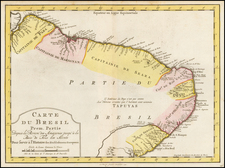
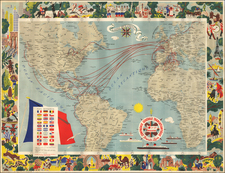
![[Unusual Italian Immigrant Communities shown!] America Settentrionale, Centrale e Meridionale -- Carta Dimostrativa Delle Ambasciate, Legazioni, Consolati (Con Le Risettive Circoscrizioni Territoriali), Camere Di Commercio, Agenzie Commerciali, Stazion Enotecniche, Uffici Postali, Ospedali, Scuole Governative e Sussidiate All'Estero](https://storage.googleapis.com/raremaps/img/small/86098.jpg)
